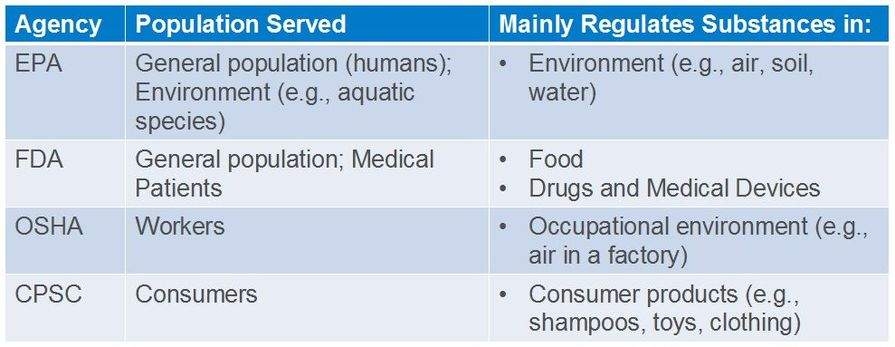5.4: Toxicología Regulatoria Nacional
( \newcommand{\kernel}{\mathrm{null}\,}\)
Después de completar esta lección, usted será capaz de:
- Definir qué se entiende por “Toxicología Regulatoria Nacional”.
- Dar un ejemplo de una regulación regulatoria nacional.
¿Qué es la Toxicología Regulatoria Nacional?
Como su nombre indica, se enfoca en la toxicología regulatoria a nivel nacional (e.g., Estados Unidos, Canadá, China). Los reglamentos son establecidos por autoridades que aplican para todo el país. El enfoque en Estados Unidos (EU) se ocupa de las regulaciones establecidas a nivel federal, y todos los estados dentro de EU deben cumplir con las regulaciones federales.

Agencias de ejemplo que establecen regulaciones nacionales de toxicología en Estados Unidos:
- Agencia de Protección Ambiental (EPA)
- Administración de Alimentos y Medicamentos (FDA)
- Administración de Seguridad y Salud Ocupacional (OSHA)
- Comisión de Seguridad de Productos de Consumo (CPSC)
Todas las agencias tienen como objetivo establecer regulaciones para proteger contra los efectos adversos para la salud derivados de la exposición a sustancias. Diferentes organismos regulan sobre diferentes tipos de sustancias, que se utilizan para diferentes propósitos y afectan a diferentes poblaciones.
El objetivo de la EPA es proteger la salud humana y ambiental; se ocupa de la exposición a sustancias en el medio ambiente (por ejemplo, aire, agua, suelo). Por lo general, se refiere a exposiciones sobre las que la población general generalmente no tiene control (por ejemplo, la contaminación del aire), así como la modernización de la regulación química en Estados Unidos, por ejemplo, la Ley de Control de Sustancias Tóxicas (TSCA) fue recientemente revisada.
TSCA se aprobó por primera vez en 1976. TSCA se revisó con la aprobación de la Ley Frank R. Lautenberg de Seguridad Química para el Siglo XXI en 2016. Regula productos químicos nuevos o ya existentes fabricados o en uso en Estados Unidos.
Tema 4: Puntos clave
En esta sección, exploramos los siguientes puntos principales:
- 1: ¿Qué es la Toxicología Regulatoria Nacional?
- 2: Ejemplos de Agencias Nacionales en Estados Unidos
- 3: ¿Qué regulan estas Agencias?
- 4: Destacar: Reforma EPA y TSCA.
1. La EPA regula los productos químicos que se encuentran en:
Alimentos
Medios ambientales (por ejemplo, agua, aire)
Medicamentos y Dispositivos Médicos
Shampoo
- Responder
-
Medios ambientales (por ejemplo, agua, aire)
2.Los Estados Unidos pueden optar por no cumplir con las regulaciones establecidas por la FDA
Cierto
Falso
- Responder
-
Falso


